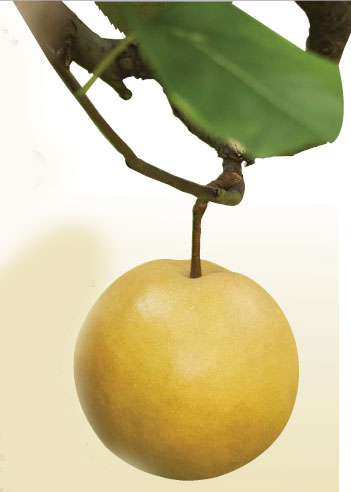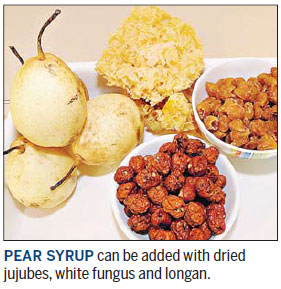Sweet pears to soothe
Updated: 2016-11-11 07:37
By Pauline D Loh(China Daily Europe)
|
|||||||||
Editor's note: To understand China, sit down to eat. Food is the indestructible bond that holds the social fabric together. It is also one of the last strong bonds of community and culture.
Five thousand years of culinary wisdom means that the Chinese have a food for every season and a dish to cure every ill.
For as long as we can remember, our elders have pointed to a plate or bowl and uttered the immortal words: "This is good for you." Sometimes, children would wrinkle their noses in disbelief, especially when it was a particularly bitter brew or a plate of liver. But in my childhood, I do remember a time when my chubby hands had actually reached out eagerly.
It was autumn, and the winds had started biting into bones, drying up the summer humidity with brisk efficiency. Throats were just as dry, and that often led to bouts of coughing to ease the itch.

That was when we'd be fed spoonfuls of pear jam or qiuligao, which is not really a jam, although it is very thick, sticky and sweet.
Instead, it is an ancient herbal concoction of grated autumn pear cooked in its own syrup with dried Chinese jujubes. Just like certain fruit jellies, the mixture is then strained of pulp and returned to the pot to thicken. Honey is added and then the concoction is bottled and doled out at the first sign of a cough during the long autumn and winter.
It was not until I started researching traditional Chinese medicine that I discovered that qiuligao has been around since the Tang Dynasty (AD 618-907) and is one of the most famous ethnic Han prescriptions.

In fact, it is so well-known that there are Beijing restaurants named after it, serving the diluted syrup in copper teapots as a main attraction, with the menu built around it.
Besides tasting good, it is, of course, full of beneficial qualities.
Chinese pears are large and very juicy, with white flesh that is almost translucent. The famous Korean or Japanese nashi pears are very similar and probably a relative. Chinese varieties grow all over the country and may vary from the huge 1-kilogram monsters from Yunnan to much smaller, delicate pears shaped like a duck torso with a rotund body topped and tailed by narrower sections.
Their names are equally attractive, like snow pears, snowflake pears, green pears and duck pears.
Pears are regarded as cooling fruits and represent the yin in balancing out the yang of summer. Pear juice cools the body and soothes the throat. A favorite drink in Hong Kong at street-side fruit juice stands is a freshly pulverized cup of foaming snow pear juice.
And it is because it is such a cooling fruit that qiuligao is made with the addition of jujubes, or the familiar dried Chinese dates. These deep maroon native fruits are known for their blood-stimulating qualities, a fiery property that offsets the chill of the autumn pears.
Traditional Chinese cures are all about achieving perfect balance in the body and so, different recipes for this pear syrup may also include ginger for heat and flavoring and crushed fritillary bulbs to speed up recuperation from coughs.
Other mild herbs such as maimendong, tiny ophiopogon tubers can also be added. These are the little creamy tubers of a long green herbal grass related to the rain lily and are used to treat throat inflammations and coughs in TCM.
This pear prescription is believed to be so effective that the Qing emperors bestowed their royal stamp of approval on it and appointed Beijing's Tongrentang Medical Hall as its official guardian.
Even today, Tongrentang's Autumn Pear Secret Concoction is a best-seller at the change of the seasons and used widely to soothe throat, bronchial and lung complaints.

It must be noted that a successful pear jam can only be completed with the addition of raw honey (sugar is never used). Sugar is a high-energy food that allows a build-up of bacteria when the body is weak, a fact recognized by the ancients.
Qiuligao is a sign of autumn and the impending chills of winter, and nothing builds up a warming immunity better than a hot, steaming cup of diluted pear syrup.
And, for once, it's easy to believe that it's all really good for you.
paulined@chinadaily.com.cn
Homemade Pear Syrup
Three large Chinese pears, peeled (about 1 kg)
100 g dried jujubes or Chinese red dates
200 ml organic honey
Seed the Chinese jujubes. The most effective way is to cut slightly off-center to expose the sharp seed and then ease it out. This is an important step as the seed is believed to be too "heat inducing". If you are looking for shortcuts, use the larger Xinjiang jujubes but the traditional prescription calls for the tiny fruits, which are called "chicken heart jujubes" for their size.
Grate the peeled pears directly into the pot, add the seeded Chinese jujubes and a liter of water and bring to a boil. Grated pears oxidize easily so it's best to leave the grating until you've finished work on the jujubes.
Boil until water has reduced by a third and then remove from heat.
Cool and strain to remove the fruit pulp and jujube skins, squeezing with a ladle to extract every drop of juice.
Strain the syrup once more through fine muslin.

Return the juice to the pot and continue to boil until it turns dark and syrupy. If you have no patience standing over a hot stove, place the juices in a slow cooker and cook on medium heat until thick. You must check constantly to make sure it does not burn.
Finally, stir the honey into the cooled syrup and place into sterilized jars. Refrigerate. Serve by diluting a tablespoon of syrup in a teacup of hot water.
You can easily sterilize glass jars and caps by placing them in a steamer over boiling water for 15 minutes, Cool and dry completely with clean paper towels.
Note:
This is a pleasant drink for winter that is a sweet substitute for hot tea. In cooler weather, it is just as good with ice. However, it is a very cooling drink and patients with susceptible tummies prone to diarrhea, and pregnant women, should avoid excessive intake. A cup per day is perfectly acceptable.
If using herbs such as maimendong or fritillary bulbs, they should be added together with the grated pears and boiled 10 minutes longer.
For very young children with coughs, it can be taken like an elixir. One teaspoon for toddlers from two to four. Feed babies very diluted solutions. Children above four and adults can take a tablespoon chased down with warm water.
(China Daily European Weekly 11/11/2016 page18)
Today's Top News
China, UK 'golden era' strengthens
UK business calls for a London-only visa system
First Chinese named as new Interpol chief
Chinese-Hungarian Friendship awards presented
Polls missed support for Trump
Superstars party with Jack Ma before shopping spree
Europe would elect Clinton: Poll
Obama, Trump meet at White House
Hot Topics
Lunar probe , China growth forecasts, Emission rules get tougher, China seen through 'colored lens', International board,
Editor's Picks

|

|

|

|

|

|







